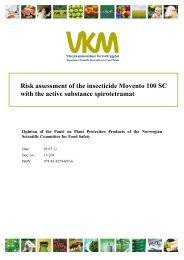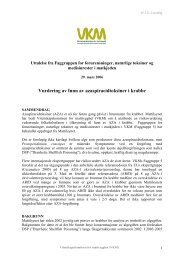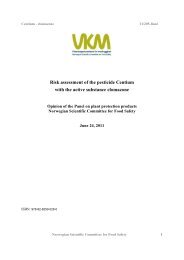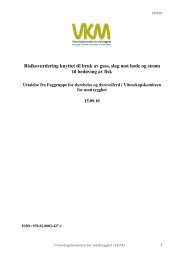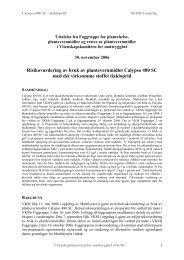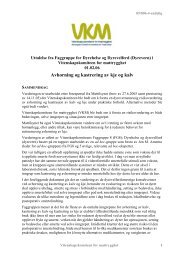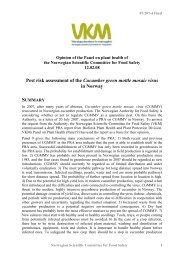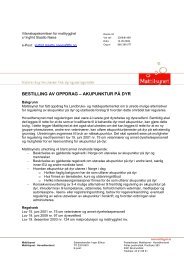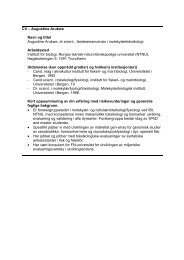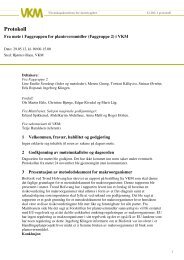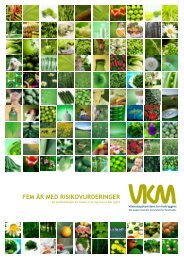Risikogruppering av aminosyrer - Vitenskapskomiteen for mattrygghet
Risikogruppering av aminosyrer - Vitenskapskomiteen for mattrygghet
Risikogruppering av aminosyrer - Vitenskapskomiteen for mattrygghet
You also want an ePaper? Increase the reach of your titles
YUMPU automatically turns print PDFs into web optimized ePapers that Google loves.
<strong>Vitenskapskomiteen</strong> <strong>for</strong> <strong>mattrygghet</strong> (VKM) Dok.nr 09-703 endelig, 28.11.11<br />
Aminoacid/compound Study, year Human/Animal N=subjects Dose (daily) Reported effects/ adverse effects<br />
Hardwick et al., 1970 Guinea pigs 3.3 mmol/kg or<br />
6.6mmol/kg<br />
methionine administration.<br />
The author suggests that an increased intake of<br />
methionine will create an unbalance in transport of<br />
several amino acids at cellular level<br />
Hypothermia, hypoglycemia, aminoacidemia, fatty<br />
liver or death.<br />
Hepatic ATP concentration decreased after 4 hours of<br />
methionine loading. Serum concentration of blood<br />
glucose, ATP, S-adenosyl homocysteine and SAM<br />
changed. Death of guinea pigs 42 hours after a dose<br />
of 10 mmol/kg.<br />
(Dever & Elfarra, 2010) review Humans and animals Methionine is toxic in animal models. The authors<br />
suggest that methionine may be toxic in humans<br />
because hypermethionemia has an impact on<br />
methionine metabolic pathways.<br />
Mixed disulfides, products in methionine metabolism<br />
may be associated with methionine toxicity<br />
Garlick, 2006 review Humans 0.1mg/kg Methionine dose does not seem to be related to any<br />
adverse events in healthy subjects.<br />
N-acetyl-L-cysteine (Liu et al., 2010) Healthy subjects, cross over<br />
study<br />
Concentration of plasma total homocysteine<br />
increases.<br />
In infants, methionine dose 200 to 500 mg/kg resulted<br />
in impaired growth and extremely high plasma<br />
methionine.<br />
24 600 mg 1 subject had increased concentration of bile acid<br />
which was not considered to be related to NAC.<br />
Ornithine Meaume et al., 2009 Humans 60+(85) 10 g/day Mild gastrointestinal events. Diarrhoea, vomiting<br />
Proline Popa et al., 1977 Sexually immature children 5 boys and 4<br />
girls<br />
S-adenosyl methionine<br />
500 mg/kg bw Growth hormone (GH) release<br />
Kim et al., 2009 Humans 67 Adverse events were recorded in 18 subjects; GI,<br />
cardiopulmonary, systemic and skin<br />
Goren et al., 2004 Healthy subjects 15 400mg/day <strong>for</strong> 2<br />
days, 800mg/day<br />
<strong>for</strong> 2 days and then<br />
1600mg/day<br />
Concentration of SAM in plasma was different after<br />
treatment. Risk of mania, mild symptoms of central<br />
nervous system and gastro intestinal symptoms.<br />
One subject was withdrawn from the study due to<br />
serious manic state.<br />
16



